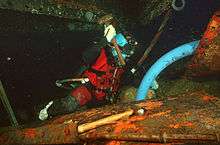Salvage diving
Salvage diving is the diving work associated with the recovery of all or part of ships, their cargoes, aircraft, and other vehicles and structures which have sunk or fallen into water. In the case of ships it may also refer to repair work done to make an abandoned or distressed but still floating vessel more suitable for towing or propulsion under its own power. The recreational/technical activity known as wreck diving is generally not considered salvage work, though some recovery of artifacts may be done by recreational divers.
Most salvage diving is commercial work, or military work, depending on the diving contractor and the purpose for the salvage operation, Similar underwater work may be done by divers as part of forensic investigations into accidents, in which case the procedures may be more closely allied with underwater archaeology than the more basic procedures of maximum cost/benefit expected in commercial and military operations.
Clearance diving, the removal of obstructions and hazards to navigation, is closely related to salvage diving, but has a different purpose, in that the objects to be removed are not intended to be recovered, just removed or reduced to a condition where they no longer constitute a hazard. Many of the techniques and procedures used in clearance diving are also used in salvage work.
Range of salvage activities
The US Navy considers the recovery of sunken or wrecked naval craft, submarines, human remains, critical items of equipment needed to determine the cause of a mishap, including classified and sensitive materials to be within the scope of their salvage and recovery operations.[1]
Planning of salvage diving operations
Information gathering
Detailed information of the layout and structure of the vessel to be salvages and the type and location of cargo are useful for planning and essential for the actual salvage operation. Information acquired during the planning stage can greatly facilitate the actual operation.[1]
If the vessel is to be raised, details of the cause of sinking and the extent of damage is required.
Useful information can be gathered from ships plans, cargo manifests, loading plans, interviews with witnesses and survivors, photographs and official reports of similar accidents.[1]
Hazards common to salvage diving
- Fouling and entrapment
- Contamination by dangerous and toxic materials
- Pressure differentials due to water movement
- Unintended explosions
Salvage diving techniques
Scuba is not authorised for most salvage work by commercial or naval operators due to relatively high risk in comparison to surface supplied techniques, though naval operations may use scuba for non-penetrative work in good visibility and relatively shallow depths.[1]
The choice between surface oriented and saturation diving is based largely on depth and the amount of decompression anticipated.
Underwater work techniques used in salvage work
- Cutting
- Welding
- Explosive demolition
- Lifting
Support equipment and ROVs
-

US Navy divers descending to a wreck to recover petroleum from a sunken ship.
-

A Japanese Ko-hyoteki class midget submarine, raised in Sydney Harbour
-

USS Squalus in drydock after salvage
-

Salvage of a U.S. Navy Consolidated PBY-5 Catalina at Casco Cove, Attu, Alaska (USA), on 27 August 1943.
-

-
%2C_prepares_to_get_underway_for_salvage_and_diving_operations_in_the_aftermath_of_Hurricane_Katrina_along_the_Gulf_Coast.jpg)
-

-

-
_2_from_Naval_Amphibious_Base_Little_Creek%2C_Va.%2C_surfaces_after_completing_a_salvage_dive.jpg)
-
_1_and_Australian_Clearance_Diving_Team_4_(AUSCDT)_4_secure_wreckage.jpg)
-
_2%2C_maneuvers_a_sunken_ship's_scr.jpg)
-
_1_makes_a_cut_on_a_sunken_vessel_at_Kuantan_Harbor_during.jpg)
-

-
_2%2C_and_teams_from_partner_nations_Panama%2C_Columbia_and_Peru_used_lift_bags_to_bring_a_boat_to_the_surface.jpg)
-

References
- 1 2 3 4 US Navy (2006). US Navy Diving Manual, 6th revision. United States: US Naval Sea Systems Command. Retrieved 2008-06-15.
